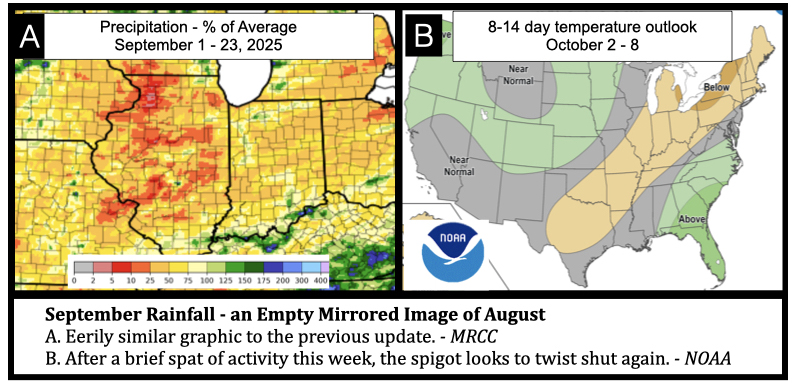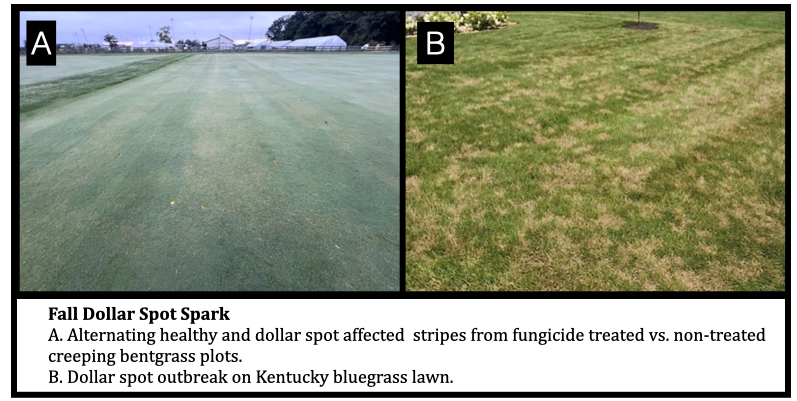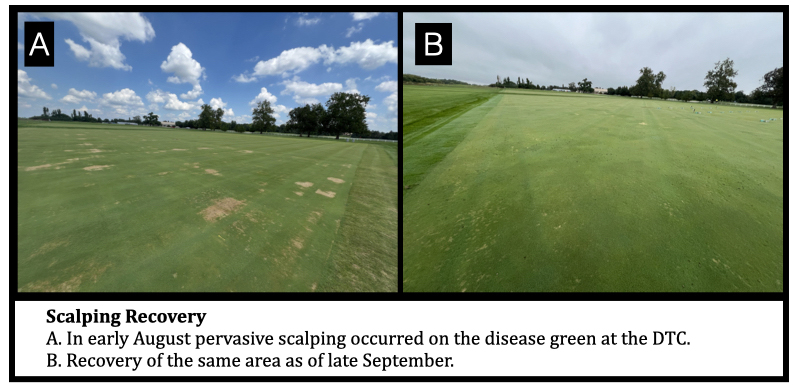Drought impacting lawns for a variety of reasons ; dollar spot resurgence on creeping bentgrass and Kentucky bluegrass; scalping and decline in relation to nitrate spikes on putting greens.
Weather

While summer is officially over and meteorological fall began this week, the “false fall” of early September is officially gone. Above average temperatures have reigned over the region since September 10th, more than offsetting the cool period earlier in the month and causing sweat to pour again with temperatures tickling the 90s in mid-Indiana. Average two-inch soil temperatures are still in the low 70s in much of the region, meaning the microbes are still working and good grass germination should be occurring. Fortunately, although it’s “hot”, the photoperiod is just about half of the day length, meaning the duration of sun and heat is reduced by 2-2.5 hours compare to July. This means cool season turfgrass stress should be low and health should be recovering if…

There was water. September followed the mold of August with a considerable lack of precipitation through much of the month. Recent rains totaling an inch or more in some locales cloud the fact that August and September have received woefully low rainfall totals. Over the past two months, much of the region has only received 2-3 inches total which is the amount that should be received in just one month. This lack of rainfall has plunged the region into moderate and severe drought categories (some extreme in SW Kentucky) and some very dusty crop harvests. Dry and dusty lawns have also been the norm over the past two months, and the short term two-week forecast doesn’t indicate much relief.
Drought Impact on Lawns

Early fall drought symptoms have been problematic on many non-irrigated lawns in Indiana over the last few weeks, with several samples arriving into the diagnostic lab. In many cases, the beige hue of drought dormancy in the hardier grasses such as newer varieties of tall fescue and Kentucky bluegrass (examples here) is quickly reversed when refreshing rainfall returns. In some cases, however, the decline may be permanent, spurred on by various other factors. Some of these to be aware of are below.
- Look alikes – Drought symptoms often appear very similar to disease and perhaps even more closely, to insect damage. Damage from chinch bugs, grubs, armyworm and other insects may also be the culprits of injury so it’s important to scout seemingly drought damaged turfgrass closely.
- Mowing – Drought stressed turfgrass that is continually trafficked and mowed has less chance for recovery. Quite simply if it isn’t growing, then we shouldn’t be mowing.
- Turfgrass species choice – Perennial ryegrass is not as drought susceptible as other cool season species and shouldn’t be a major constituent of most lawns, particularly in southern Indiana and the transition zone. Kentucky bluegrass often needs more water to stay green than tall fescue, which is considered more drought tolerant. Both of these species, however, will go into and come out of drought dormancy with much more success than perennial ryegrass.
- Soil – Home lawns on clayey subsoil left behind from construction and topsoil thievery are more difficult to irrigate and less receptive to rainfall. Turfgrass will accumulate its own organic matter and reclaim the microbial diversity and water retention of a soil, but it takes considerable time. In some cases, topdressing with a trusted compost, organic matter or topsoil can aid established lawns.
- Thatch – A sponge that steals water from the roots. Sitting on the top of a clay soil is a recipe for a very parched grass throat. Kentucky bluegrass with its rhizomatous growth habit is most prone to thatch development.
- Time of year – Late summer/early fall is potentially the worst time for an abnormal environment stress event on cool season turfgrasses. Cooler temperatures and shorter day lengths promote plant growth, but roots are at their shortest after a long summer and fertilization is needed.
Dollar Spot Resurgence

Dollar spot has returned in its normal fall vengeance over the last two weeks. Heavy dews and fog have sparked considerable activity on our research plots and Kentucky bluegrass lawns have also been affected. Fall outbreaks can be more difficult to control since nitrogen may be in shorter supply in the plant due to reduced root uptake or fertilizer addition, and the population may be higher than in spring since it’s had all season to propagate. In addition, low soil moisture levels, which have been in ample supply, were correlated with increased dollar severity by a team of researchers including Dr. Bigelow (McDonald et al. 2006). Addition of nitrogen can aid in recovery and dollar spot on lawns is often an indicator that fertilization is needed.
Scalping & Nitrate Levels on Putting Greens

Needless to say, 2025 was an especially tough year on the health of bentgrass putting greens. Apart from disease activity and straight physiological decline, many experienced puffiness and resulting scalping issues. At the Daniel Turfgrass Center, we were not immune, as in early August scalping occurred on most of my research plots.
At the same time, several superintendents experiencing decline reported (and in some cases blamed) exceptionally high nitrate levels in areas of turfgrass decline and/or scalping. These superintendents were scrambling to adjust and, in some cases, completely restrict nitrogen spoonfeeding, while at the same time increasing the frequency and rate of plant growth regulator application. However, this stress and reaction potentially targeted the wrong problem.
Since I’m not a fertility specialist, I contacted two colleagues that are, Dr. Travis Shaddox and Dr. Doug Soldat, and posed this question. Earlier instruction charted my thought that nitrogen levels in the soil are dynamic, and soil tests were not a reliable guide to actionable fertilizer inputs. Fortunately, both Drs. Shaddox and Soldat affirmed this by stating the obvious. If the plant uptake is limited (the sink), then nitrate levels in the soil (the source) are bound to accumulate. Soil microbes rapidly churning organic matter into nitrogen in high summer temps don’t stop the factory because the plant is under duress. Therefore, nitrates naturally accumulate. When taking a soil sample from a struggling or dead area of turfgrass to aid in diagnosis, one should expect nitrogen levels to be elevated and a “result of”, rather than a “cause of” the problem – T. Shaddox. Thank you to both Doug and Travis for reminding me and clarifying this point.
With this being said, the scalping on my research plots and potentially these samples are presumably due to the comorbidity of disease activity and/or turfgrass stress. Two weeks prior, we observed considerable brown patch activity in untreated plots and treatments that did not provide control, and in these plots the scalping was most pronounced. Interestingly, only my research plots scalped, while all other putting green research areas with diseases controlled were left unscathed. Now, don’t hear what I’m not saying. Fungicides are not a recommended replacement for plant growth regulator use on putting greens. However, a clogged sink drain may play a role in scalping occurrence and keeping it clear is a good idea under low bedknives.